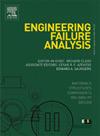高炉风口的失效机理和缓解策略:全面回顾
IF 4.4
2区 工程技术
Q1 ENGINEERING, MECHANICAL
引用次数: 0
摘要
炼铁高炉是一个巨大的逆流反应器,每年生产 19 亿吨钢铁中的大部分。在高炉的各种部件中,从高炉无间断平稳运行的角度来看,由带保护层的高纯度铜制成的风筒最为关键。这些水冷铜风箱将温度在 1200-1300 °C之间的预热鼓风喷入高炉,用于氧化焦炭,随后从气态还原剂中还原铁矿石。在本综述文章中,阐明了风口的不同失效机理,并从风口的制造、设计和涂层应用、操作影响以及高炉所用原材料的质量等角度阐述了失效的根本原因。主要失效机制包括熔渣和铁液造成的熔化损失、煤粉造成的侵蚀、涂层内的冶金偏析和异质性加剧的热疲劳、锌扩散诱导的黄铜形成以及导热性降低和氯化物诱导的腐蚀开裂造成的后续劣化。本研究对提高铜水口可靠性和使用寿命的各种策略进行了最新评述,并提出了进一步研究的方向。预计这将对高炉操作以及故障分析师和研究人员有所裨益,有助于提高风口和其他铜制部件的可靠性。本文章由计算机程序翻译,如有差异,请以英文原文为准。
Failure mechanisms of blast furnace tuyeres and mitigation strategies: A comprehensive review
Iron blast furnace is a gigantic counter-current reactor and contributes to the majority of ∼1.9 billion tonnes of steel produced annually. Among various components of the blast furnace, tuyeres made of high-purity copper with protective coatings are the most critical in nature from the viewpoint of smooth furnace operation without interruptions. These water-cooled copper tuyeres inject preheated blast between 1200–1300 °C into the furnace for oxidation of coke and subsequent reduction of iron ore from the gaseous reductants. In the present review article, different failure mechanisms of the tuyeres are clarified, and the underlying reasons are stated from the viewpoint of the manufacturing aspects of the tuyeres, its design and application of coatings, operational effects and the quality of raw materials being used in the blast furnace. Predominant failure mechanisms include melting loss due to slag and liquid iron, erosion caused by pulverized coal, thermal fatigue exacerbated by the metallurgical segregation and heterogeneities within the coatings, Zn-diffusion induced Brass formation and subsequent deterioration due to reduced thermal conductivity and chloride induced corrosion cracking. A state-of-the-art review of various strategies for improved reliability and service life of Cu tuyere and way forward for further research is proposed in this work. It is expected to benefit the blast furnace operations as well as failure analysts and researchers working to improve the reliability of the tuyeres and other components made of Cu.
求助全文
通过发布文献求助,成功后即可免费获取论文全文。
去求助
来源期刊

Engineering Failure Analysis
工程技术-材料科学:表征与测试
CiteScore
7.70
自引率
20.00%
发文量
956
审稿时长
47 days
期刊介绍:
Engineering Failure Analysis publishes research papers describing the analysis of engineering failures and related studies.
Papers relating to the structure, properties and behaviour of engineering materials are encouraged, particularly those which also involve the detailed application of materials parameters to problems in engineering structures, components and design. In addition to the area of materials engineering, the interacting fields of mechanical, manufacturing, aeronautical, civil, chemical, corrosion and design engineering are considered relevant. Activity should be directed at analysing engineering failures and carrying out research to help reduce the incidences of failures and to extend the operating horizons of engineering materials.
Emphasis is placed on the mechanical properties of materials and their behaviour when influenced by structure, process and environment. Metallic, polymeric, ceramic and natural materials are all included and the application of these materials to real engineering situations should be emphasised. The use of a case-study based approach is also encouraged.
Engineering Failure Analysis provides essential reference material and critical feedback into the design process thereby contributing to the prevention of engineering failures in the future. All submissions will be subject to peer review from leading experts in the field.
 求助内容:
求助内容: 应助结果提醒方式:
应助结果提醒方式:


